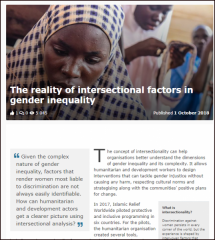The Reality of Intersectional Factors in Gender Inequality
In 2017, Islamic Relief Worldwide piloted protective and inclusive programming in six countries. For the pilots, the humanitarian organisation created several tools, including an intersectionality framework to help understand gender identities, their social positions and immediate and strategic impacts.
To identify the women at risk of exclusion, Islamic Relief started using a model based on a gender analysis of power and influence. The model analyzes the underlying power structures that define public discourse; as everybody carries multiple identities, there is a tendency not to immediately spot factors that render women most liable to discrimination.
Source: European Union
Date of Publication: March 10, 2021
SIMILIAR RESOURCES
Tools
Examples
- FGM Infographics
- Training Toolkit on MSM Programming for the MENA Region
- Entertainment-Education Curriculum
- Noora Health COVID-19 Resources
- Gender Norms, Intersectionality and Social Protection: In Conversation with UNICEF's Dr Zahrah Nesbitt-Ahmed
- Community Communication MNCH e-Manual: Participatory Health Promotion Sessions
- COVID-19 Exposes the Harsh Realities of Gender Inequality in Slums
- Factors Impacting Use of Health Services by First-time/Young parents: A Formative Research Toolkit
- Lever les Tabous: La sexualité et les approches promouvant l’égalité des genres pour mettre fin aux unions et aux mariages d’enfants, précoces et forcés
- Senegal Malaria Communication Strategy 2016-2020
- The Reality of Intersectional Factors in Gender Inequality
- Arab Women Speak Out: Profiles of Self Empowerment
- Provider Survey and Segmentation Findings
- Beyond Bias: Provider Survey and Segmentation Findings
- Beyond Bias Literature Review and Expert Interviews on Provider Bias in the Provision of Youth Contraceptive Services:

